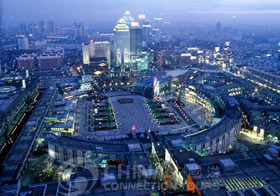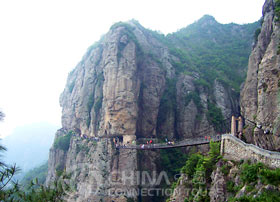 Ningbo is a famous historical and cultural city, which has been acclaimed as "the state of cultural relics." It is an important industrial base in Zhejiang Province and a major producer of grain, cotton, edible oil and aquatic products in China.
Ningbo is a famous historical and cultural city, which has been acclaimed as "the state of cultural relics." It is an important industrial base in Zhejiang Province and a major producer of grain, cotton, edible oil and aquatic products in China.
Geographic Features
Ningbo is located in the middle part of China's coastline and on the eastern part of Ning-shao Plain in Zhejiang Province. With Zhoushan Archipelago as its natural barrier in the east, bordering Hangzhou Bay in the north and Sanmen Bay in the south, adjacent to Shaoxing city in the west and connecting with Taizhou city. Ningbo possesses two main mountain ranges within its boundaries, Siming Mountain and Tiantai Mountain. As one of the eight river systems of Zhejiang province, Ningbo is rich in water resources. Ningbo has a long coastline, with tortuous harbors and scattered islands. Ningbo occupies a total sea area of 9758 sq. km and a total coastline of 1,562 km including 788 km of mainland coastline and 774 km of island coastline, which takes one third of the coastline of Zhejiang Province. There are 531 islands in Ningbo with a total area of 524.07 sq. km.
Ningbo enjoys a subtropical monsoon climate featuring mild temperatures, moderate humidity and distinctive seasons. Its average annual temperature is 16.2Co. July is the hottest month (average temp. 28.8 Co) and January the coldest (average temp. -4.2 Co). The frost-free period lasts about 230-240 days, and the crop growth period 300 days. The climate is suitable for growing grain, cotton and oil plants. The annual precipitation averages 1,300-1,400 mm. The precipitation from May to September is 60 percent of the year's total.
People
By the end 2002, Ningbo had a total population of 5.4619 million, with 2.0141 million in the urban area. Ninety-nine percent are Han Chinese. The main religion is Buddhism. The natives speak local dialect and the government language is mandarin.
History
 Ningbo, a famous foreign trade port, has a history of some 7,000 years. The people of Ningbo established the glorious "Hemudu Culture" in this area along the sea. Ningbo was a part of the Yue State during the Spring & Autumn Period, and became a part of Huiji Shire during the Qin and Han Dynasties 2,000 years ago. Trading, shipbuilding and ocean shipping were flourishing at that time in Ningbo.
Ningbo, a famous foreign trade port, has a history of some 7,000 years. The people of Ningbo established the glorious "Hemudu Culture" in this area along the sea. Ningbo was a part of the Yue State during the Spring & Autumn Period, and became a part of Huiji Shire during the Qin and Han Dynasties 2,000 years ago. Trading, shipbuilding and ocean shipping were flourishing at that time in Ningbo.
In the early stage of the Ming Dynasty, Ningbo was known as the Mingzhou Prefecture, but in 1381, the 14th year of Emperor Hongwu's reign, it was changed into Ningbo Prefecture, which it's still called today. During the Tang Dynasty , Ningbo manufactured the Tang ships and celadon china of the Yue Kiln and traded with foreign countries. It along with Guangzhou, Yangzhou and Quanzhou composed the "Silk and China Road on the Sea" at that time. In the 1840s, according to the "Five Ports Trade Treaty" which was signed with the western imperialist powers, Ningbo was forced to build a trading port, which was put into use in 1844.

